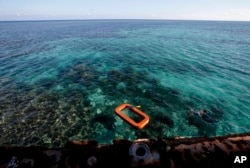ຈີນ ໄດ້ເອົາບາດກ້າວແບບເດັດຂາດ ເພື່ອເອົາຊະນະ ຄວາມບໍ່ໄວ້ວາງໃຈຂອງບັນດາ
ປະເທດໃນເຂດເອເຊຍອາຄະເນ ໃນເດືອນນີ້ ໂດຍໄດ້ຕົກລົງຮັບເອົາກົດການປະພຶດ
ປະຕິບັດ ກ່ຽວກັບ ທະເລຈີນໃຕ້ ອີງຕາມຄຳເວົ້າ ຂອງພວກນັກວິເຄາະກ່າວ ແລະກໍເປັນ
ຄັ້ງທຳອິດ ທີ່ຈະໄດ້ມີການຊ້ອມລົບທາງທະຫານຮ່ວມກັນ ທີ່ໄດ້ກຳນົດໄວ້ຫຼັງຈາກນັ້ນ.
ບັນດາກຸ່ມປະເທດອາຊຽນ ທີ່ມີສະມາຊິກ 10 ປະເທດດ້ວຍກັນ ແລະເຈົ້າໜ້າທີ່ຈາກ
ປັກກິ່ງ ໃນສັບປະດາຜ່ານມານີ້ ໄດ້ຕົກລົງກັນ ຕໍ່ຮ່າງການເຈລະຈາ ກ່ຽວກັບກົດລະບຽບ
ທີ່ຈະສາມາດຊ່ອຍປ້ອງກັນ ບໍ່ໃຫ້ເກີດເຫດຮ້າຍ ໃນການຜິດຖຽງກັນທາງທະເລ. ທະເລ
ຈີນໃຕ້ ແມ່ນອ້າງເອົາກຳມະສິດໂດຍ 6 ລັດຖະບານແລະເປັນເຂດທີ່ເກີດເຫດການຫຼາຍ
ຄັ້ງ ນັບຕັ້ງແຕ່ຊຸມປີ 1970 ເປັນຕົ້ນມາ.
ລັດຖະມົນຕີການຕ່າງປະເທດຈີນ ທ່ານ ຫວັງ ຢີ ໄດ້ກ່າວວ່າ ເອກກະສານນີ້ຈະຊ່ອຍ
ໃນການ “ພິສູດວ່າ ຈີນ ແລະບັນດາສະມາຊິກຂອງກຸ່ມປະເທດອາຊຽນ ແມ່ນມີຄວາມສາມາດຮັກສາສັນຕິພາບ ແລະສະຖຽນລະພາບໄວ້ໄດ້,” ອີງຕາມອົງການຂ່າວຊິນຫົວ
ຂອງທາງການຈີນນັ້ນ.
“ອັນນີ້ ຖືວ່າ ແມ່ນຄວາມກ້າວໜ້າ ເມື່ອເວົ້າເຖິງ ການບໍ່ມີການຜິດຖຽງກັນຢ່າງເປີດ
ເຜີຍ ພາຍໃນກຸ່ມອາຊຽນ ແລະລະຫວ່າງອາຊຽນ ກັບຈີນ,” ຊຶ່ງທ່ານເອີດວດໂດ ອາຣາ
ໂຣລ ຮອງສາສະດາຈານຈາກສະຖາບັນນະໂຍບາຍສາທາລະນະຂອງມະຫາວິທະຍາ
ໄລແຫ່ງຊາດສິງກະໂປ ໄດ້ກ່າວໄວ້.
China took a decisive step toward winning over wary Southeast Asian countries this month by agreeing to the outline of a code of conduct for the South China Sea, analysts say, and first-ever joint military exercises are set to follow.
The 10-member Association of Southeast Asian Nations (ASEAN) and officials from Beijing last week gave the long-awaited nod to a draft negotiating text for a code that would help prevent mishaps in the disputed waterway. The South China Sea is contested by six governments and has been accident-prone since the 1970s.
Chinese Foreign Minister Wang Yi said the text would help "prove that China and ASEAN member states are capable of maintaining peace and stability," according to China's official Xinhua News Agency.
"This one is probably considered progress in terms of the absence of open bickering within ASEAN and between (ASEAN and) China," said Eduardo Araral, associate professor at the National University of Singapore's public policy school.
The agreement reached in Singapore at a China-ASEAN foreign ministers' meeting precedes first-ever joint military drills later this year, officials at the event were quoted as saying.
ASEAN members Brunei, Malaysia, the Philippines and Vietnam claim resource-rich South China Sea tracts that overlap Chinese-controlled waters.
Sovereignty disputes have particularly chilled Sino-Vietnamese and Sino-Philippine relations at times over the past five decades as China expands onto some of the sea's once uninhabited islets, in some cases for military use. Its expansion has brought the U.S. Navy in to support the militarily weaker Southeast Asian states, in turn upsetting Beijing.
Significance for China
Last year China and ASEAN agreed to keep trying for a code of conduct, after about a decade of stalling by Beijing. The code would establish ways to prevent ship collisions and other mishaps, but it would not address sovereignty issues. It could be signed by year's end.
Vietnam and China experienced deadly clashes in 1974 and 1988 over competing maritime claims. In 2014 the two sides rammed each other's boats as China allowed an oil firm to position its rig in a disputed tract of the sea. In 2012, Chinese vessels became locked in a standoff with the Philippines.
The militarily more powerful United States has passed naval ships through the sea eight times under President Donald Trump, who is also pressuring China on trade. U.S. allies such as Australia, Japan and France have sent their own vessels in support of the U.S. position that the sea should remain open internationally.
Washington and its allies have also reached out to support ASEAN members with South China Sea claims with joint naval exercises and arms sales.
"China has been anxious to demonstrate its hopes for peace and security and prosperity in the South China Sea, and since it's a major future party to this code of conduct, it would take this opportunity to say well, there's huge progress,'" said Oh Ei Sun, international studies instructor at Singapore Nanyang University.
A finalized code would eventually make maritime relations more regulated by "rule of law," he said, though day-to-day those relations may be "dictated by realpolitik."
Single negotiating text
The negotiating text agreed to last week combines the proposals of all parties for future negotiations, analysts say. In the past ASEAN members Cambodia and Laos had opposed any criticism of China, stalling code of conduct talks.
But the unified text will not necessarily make negotiations easier or faster, said Collin Koh, maritime security research fellow at Nanyang Technological University, also in Singapore.
First-ever military exercises
Inaugural China-ASEAN military drills would not go too far at first, Koh said. They would cover responses to "maritime emergencies" and probably take their guidance from the 21-nation Code for Unplanned Encounters at Sea signed in 2014, he said.
"Politically, there is still a lack of trust between the various parties when you look at the South China Sea context, so you wouldn't want to exercise something complex and sensitive," Koh said."If you make it too complex, you are going to alienate some of the ASEAN member states, because their navies may not have that capability to even participate in this sort of exercise."
China has sparked the military movement over the past year by Western allies largely by militarizing islets in the sea's Spratly chain and others in the Paracel archipelago.
Beijing claims those islets along with about 90 percent of the 3.5 million-square-kilometer sea, which is prized for fisheries, marine shipping lanes and reserves of oil and natural gas. Chinese officials citehistorical records to back their claims. They held their own maritime exercises in April.
China was also uninvited to U.S. Navy-led RIMPAC exercises in June and July. The series of live-fire drills and scenario-based exercises brought together 25,000 people from 25 countries, including Brunei, Malaysia, the Philippines and Vietnam.





